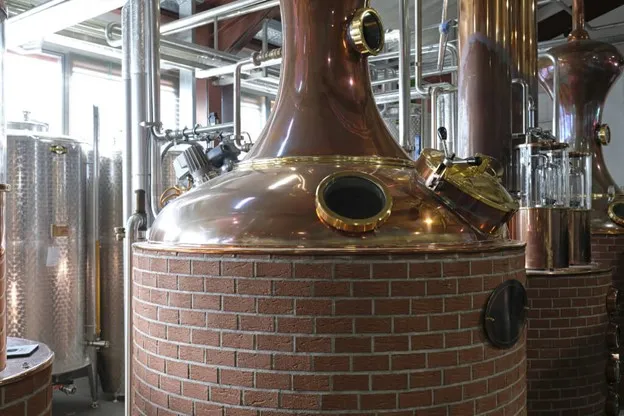The comeback of the pot still in Scotch grain whisky production is something we can’t overlook. Traditional pot stills, replaced by column stills in the 19th century due to their higher yield and efficiency, are making a spectacular comeback. We’re seeing a resurgence of interest in grain whisky made using pot stills, a process that yields a different and, some would argue, superior flavor profile.
Analyzing the resurgence of the pot still, one cannot dismiss the implication it holds for the whisky industry. This revival is a nod to tradition, signaling a departure from mass-produced spirits towards spirits that emphasize character and flavor. Additionally, this shift also indicates that consumers are willing to pay a premium for quality, artisanal products – a notable trend impacting not just whisky, but the entire alcohol beverage industry.
Grain Whisky and Pot Stills
Rewinding to the early days of whisky distillation, pot stills were the devices of choice. But the introduction of the continuous or column still in the 1830s, which made it possible to produce spirit continuously and at a high proof, led to a change in the landscape. This shift not only transformed the industry but also the flavor profiles of Scotch grain whiskies. The return of the pot still to grain whisky production suggests a growing desire among connoisseurs to return to the roots of distillation, in pursuit of depth and complexity of flavor.
It’s interesting to understand how distillation techniques evolved in response to societal needs. The move towards column stills in the 19th century was largely due to the growing industrialization and demand for whisky. Now, the shift back to pot stills reflects a reaction against industrialization – a yearning for craftsmanship, tradition, and the art of distillation.
The Pot Still
Understanding the pot still’s revival calls for a deeper examination of the pot still itself. It’s a simple device, often made of copper, with a large, pot-like base and a swan-neck tube leading out from the top. The pot still method is a batch process, where the fermented grain is heated in the pot, the vapors collected, condensed, and then collected as liquid spirit. This method emphasizes the quality of the product, not the quantity, resulting in a whisky with a more robust and distinctive flavor.
Digging deeper into the pot still’s workings, it’s a marvel how such a simple device can yield such complex flavors. It is the craft of the distiller – their careful attention to temperature, the cut points between the head, heart, and tail of the distillate – that extracts the desirable flavors and aromas. This highlights the skill and craftsmanship that goes into pot still distillation, adding another layer of appreciation for pot-distilled spirits.
The Column Still
In contrast, the column still, or continuous still, is a more modern, efficient device that allows for continuous distillation. The column still operates by vaporizing the entire wash and re-condensing it in a single, continuous process. This method results in a lighter, cleaner spirit, which can be distilled to a much higher strength. While this approach allows for mass production, some whisky lovers argue it lacks the nuance and character of pot-distilled spirits.
As for the column still, its effect on flavor and mass production is double-edged. On the one hand, the column still has democratized whisky, making it accessible to a larger audience. On the other hand, it has resulted in a homogenization of flavor profiles. Thus, the column still’s prominence raises questions about the balance between accessibility and uniqueness in whisky production.
Pot Distilled Grain Whisky
In an interview with an experienced distiller, he noted, “The pot still processes grain whisky with a richer, deeper flavor profile. You get a lot of those heavier, oilier components that are stripped out in column still distillation. You’re looking at a more full-bodied whisky, with a complexity that is hard to match with continuous stills.”
Elaborating on the flavor profiles of pot distilled grain whisky, it’s worth noting that these robust, oilier components often lead to long, satisfying finishes. These spirits are likely to evolve and reveal new layers of flavor as they open up in the glass. Moreover, the complexity of these whiskies often translates into excellent aging potential, adding another dimension for collectors and connoisseurs.
Rise of Artisanal Whiskies
A revival in pot still grain whisky production reflects wider industry trends. Many consumers are gravitating towards artisanal products and show a preference for traditional methods over industrial-scale operations. This is part of a broader “craft” movement that values quality and authenticity over quantity and convenience.
With regard to market trends, the rise of artisanal whiskies ties into a broader societal shift towards conscious consumption. Consumers are not just interested in the end product but also in its origins and production methods. This increased awareness and preference for craft products elevate the significance of the pot still’s revival, as it meets consumer desire for authenticity and transparency.
Sustainable Distilling
Another reason behind the pot still revival is a push towards more sustainable practices in whisky production. Although pot stills are not as efficient as column stills, they require less energy to operate and can be powered by renewable energy sources. Many distilleries are turning to this traditional method to reduce their environmental footprint, as it aligns with the increasingly prevalent ethos of sustainability in the beverage industry.
The topic of environmental impact brings up interesting points about the future of distilling. While pot stills require less energy, they are not as efficient in terms of yield. This opens up avenues for innovation and research into how pot still distillation can be made more efficient without compromising on quality, making this ancient method fit for the future.
Collecting and Tasting
For collectors and whisky enthusiasts, the pot still revival opens up a new world of Scotch grain whiskies to explore. When tasting, look for the fuller-bodied, complex characteristics associated with pot still distillation. This can include robust grain notes, an oily mouthfeel, and an array of flavor components that might be absent from column-distilled counterparts.
The resurgence of pot still grain whisky production is a cause for celebration among whisky aficionados worldwide. It opens up a world of new possibilities, inviting us to embark on a journey of exploration, collection expansion, and a deeper appreciation for this remarkable spirit. As whisky lovers, we raise our glasses in tribute to the triumphant return of the pot still.
Pot still grain whiskies present an exciting avenue for enthusiasts to discover and indulge in. These whiskies, with their captivating and complex profiles, add a distinctive touch to any collection, showcasing the discerning taste of the collector. Moreover, when savoring these whiskies, connoisseurs have the opportunity to explore the art of pairing them with various cuisines, unveiling the intricate layers of flavors and enhancing the overall tasting experience.
For those eager to explore the world of pot still grain whiskies and expand their collection, online platforms such as WhiskeyD offer a treasure trove of exceptional Scotch whiskies. With a curated selection of the finest offerings, WhiskeyD provides whisky lovers with a gateway to discover and acquire the best pot still expressions available.

